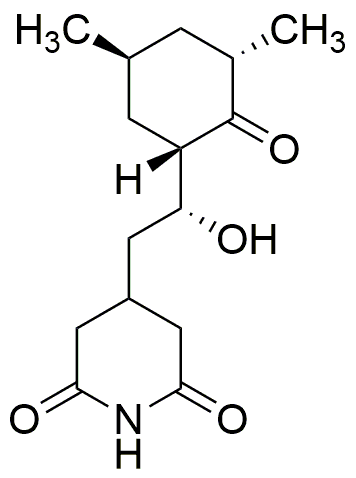Cycloheximide is widely utilized in research focused on:
- Protein Synthesis Inhibition: It is primarily used to inhibit protein synthesis in eukaryotic cells, making it a valuable tool for studying cellular processes and the effects of specific proteins in various biological pathways.
- Cell Biology Studies: Researchers use cycloheximide to investigate the role of specific proteins in cell signaling and metabolism, helping to elucidate mechanisms of diseases, including cancer.
- Pharmaceutical Development: In drug development, it serves as a model compound to test the efficacy of new therapeutic agents that target protein synthesis, providing insights into potential treatments.
- Microbiology: It is utilized in microbiological studies to understand the effects of antibiotics on protein synthesis in bacteria, aiding in the discovery of new antimicrobial agents.
- Neuroscience Research: Cycloheximide is applied in studies of neurodegenerative diseases, allowing scientists to explore the impact of protein synthesis on neuronal health and function.
Informations générales
Propriétés
Sécurité et réglementation
Applications
Cycloheximide is widely utilized in research focused on:
- Protein Synthesis Inhibition: It is primarily used to inhibit protein synthesis in eukaryotic cells, making it a valuable tool for studying cellular processes and the effects of specific proteins in various biological pathways.
- Cell Biology Studies: Researchers use cycloheximide to investigate the role of specific proteins in cell signaling and metabolism, helping to elucidate mechanisms of diseases, including cancer.
- Pharmaceutical Development: In drug development, it serves as a model compound to test the efficacy of new therapeutic agents that target protein synthesis, providing insights into potential treatments.
- Microbiology: It is utilized in microbiological studies to understand the effects of antibiotics on protein synthesis in bacteria, aiding in the discovery of new antimicrobial agents.
- Neuroscience Research: Cycloheximide is applied in studies of neurodegenerative diseases, allowing scientists to explore the impact of protein synthesis on neuronal health and function.
Documents
Fiches de données de sécurité (FDS)
La FDS fournit des informations de sécurité complètes sur la manipulation, le stockage et l’élimination du produit.
Spécifications du produit (PS)
Le PS fournit une description complète des propriétés du produit, notamment sa composition chimique, son état physique, sa pureté et les exigences de stockage. Il détaille également les plages de qualité acceptables et les applications prévues du produit.
Certificats d'analyse (COA)
Recherchez des certificats d'analyse (COA) en saisissant le numéro de lot du produit. Les numéros de lot et de lot se trouvent sur l'étiquette d'un produit, après les mots « Lot » ou « Lot de fabrication ».
Numéro de catalogue
Numéro de lot/série
Certificats d'origine (COO)
Ce certificat d'exploitation confirme le pays dans lequel le produit a été fabriqué, et détaille également les matériaux et composants utilisés et s'il est issu de sources naturelles, synthétiques ou autres sources spécifiques. Ce certificat peut être requis pour les douanes, le commerce et la conformité réglementaire.
Numéro de catalogue
Numéro de lot/série
Fiches de données de sécurité (FDS)
La FDS fournit des informations de sécurité complètes sur la manipulation, le stockage et l’élimination du produit.
DownloadSpécifications du produit (PS)
Le PS fournit une description complète des propriétés du produit, notamment sa composition chimique, son état physique, sa pureté et les exigences de stockage. Il détaille également les plages de qualité acceptables et les applications prévues du produit.
DownloadCertificats d'analyse (COA)
Recherchez des certificats d'analyse (COA) en saisissant le numéro de lot du produit. Les numéros de lot et de lot se trouvent sur l'étiquette d'un produit, après les mots « Lot » ou « Lot de fabrication ».
Numéro de catalogue
Numéro de lot/série
Certificats d'origine (COO)
Ce certificat d'exploitation confirme le pays dans lequel le produit a été fabriqué, et détaille également les matériaux et composants utilisés et s'il est issu de sources naturelles, synthétiques ou autres sources spécifiques. Ce certificat peut être requis pour les douanes, le commerce et la conformité réglementaire.


